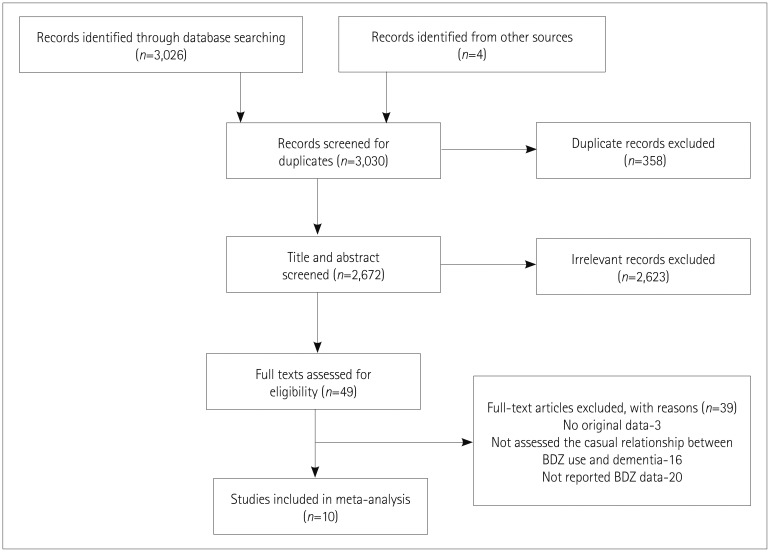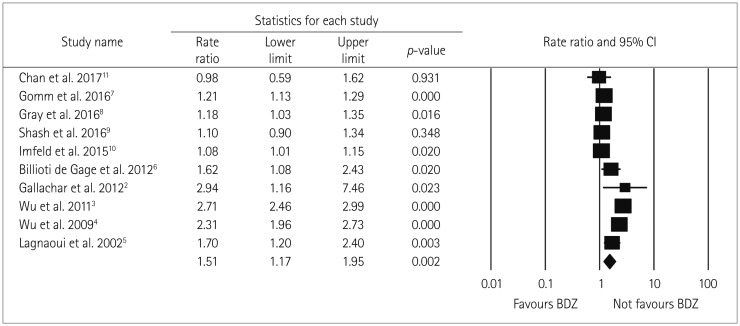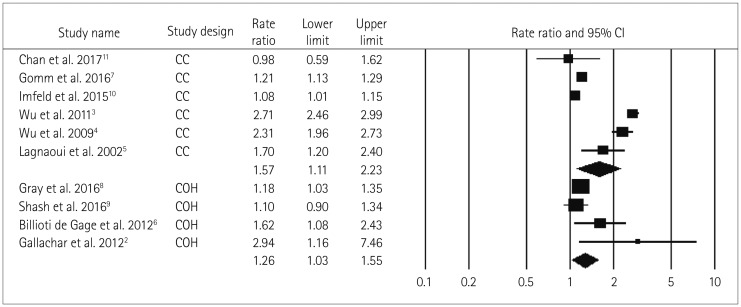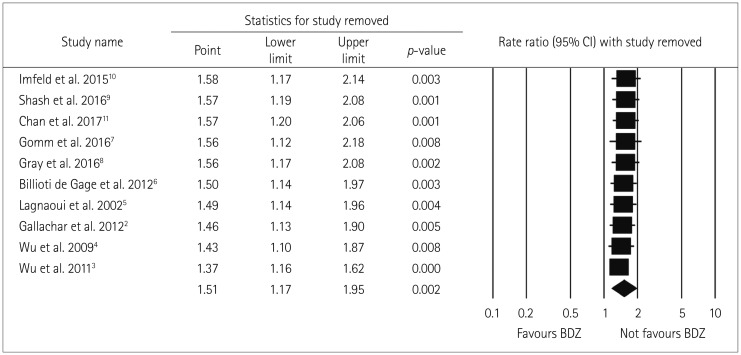J Clin Neurol.
2019 Jan;15(1):9-19. 10.3988/jcn.2019.15.1.9.
Risk of Dementia in Long-Term Benzodiazepine Users: Evidence from a Meta-Analysis of Observational Studies
- Affiliations
-
- 1Department of Out-Patient, West China Hospital, Sichuan Uniwersity, Chengdu, China.
- 2Department of Nursing, West China Hospital, Sichuan Uniwersity, Chengdu, China.
- 3Department of Pharmacy, West China Hospital, Sichuan Uniwersity, Chengdu, China. FFleissnerabbse@yahoo.com
- KMID: 2451140
- DOI: http://doi.org/10.3988/jcn.2019.15.1.9
Abstract
- BACKGROUND AND PURPOSE
There is conflicting evidence in the literature on the association between benzodiazepines (BDZs) and the risk of dementia. This meta-analysis aimed to determine the relationship between the long-term usage of BDZs and the risk of dementia.
METHODS
The PubMed and Embase databases were systematically searched for relevant publications up to September 2017. The literature search focused on observational studies that analyzed the relationship between the long-term use of BDZs and the risk of dementia. Pooled rate ratios (RRs) with 95% confidence interval (CI) were assessed using a random-effects model. The robustness of the results was checked by performing subgroup and sensitivity analyses.
RESULTS
Ten studies were included: six case-control and four cohort studies. The pooled RR for developing dementia was 1.51 (95% CI=1.17-1.95, p=0.002) in patients taking BDZ. The risk of dementia was higher in patients taking BDZs with a longer half-life (RR=1.16, 95% CI=0.95-1.41, p=0.150) and for a longer time (RR=1.21, 95% CI=1.04-1.40, p=0.016).
CONCLUSIONS
This meta-analysis that pooled ten studies has shown that BDZ significantly increases the risk of dementia in the elderly population. The risk is higher in patients taking BDZ with a longer half-life (>20 hours) and for a longer duration (>3 years).
Keyword
Figure
Reference
-
1. Griffin CE 3rd, Kaye AM, Bueno FR, Kaye AD. Benzodiazepine pharmacology and central nervous system-mediated effects. Ochsner J. 2013; 13:214–223. PMID: 23789008.2. Gallacher J, Elwood P, Pickering J, Bayer A, Fish M, Ben-Shlomo Y. Benzodiazepine use and risk of dementia: evidence from the caerphilly prospective study (CaPS). J Epidemiol Community Health. 2012; 66:869–873. PMID: 22034632.
Article3. Wu CS, Ting TT, Wang SC, Chang IS, Lin KM. Effect of benzodiazepine discontinuation on dementia risk. Am J Geriatr Psychiatry. 2011; 19:151–159. PMID: 20808131.
Article4. Wu CS, Wang SC, Chang IS, Lin KM. The association between dementia and long-term use of benzodiazepine in the elderly: nested case-control study using claims data. Am J Geriatr Psychiatry. 2009; 17:614–620. PMID: 19546656.
Article5. Lagnaoui R, Bégaud B, Moore N, Chaslerie A, Fourrier A, Letenneur L, et al. Benzodiazepine use and risk of dementia: a nested case-control study. J Clin Epidemiol. 2002; 55:314–318. PMID: 11864804.6. Billioti de Gage S, Bégaud B, Bazin F, Verdoux H, Dartigues JF, Pérès K, et al. Benzodiazepine use and risk of dementia: prospective population based study. BMJ. 2012; 345:e6231. PMID: 23045258.
Article7. Gomm W, von Holt K, Thomé F, Broich K, Maier W, Weckbecker K, et al. Regular benzodiazepine and z-substance use and risk of dementia: an analysis of German claims data. J Alzheimers Dis. 2016; 54:801–808. PMID: 27567804.
Article8. Gray SL, Dublin S, Yu O, Walker R, Anderson M, Hubbard RA, et al. Benzodiazepine use and risk of incident dementia or cognitive decline: prospective population based study. BMJ. 2016; 352:i90. PMID: 26837813.
Article9. Shash D, Kurth T, Bertrand M, Dufouil C, Barberger-Gateau P, Berr C, et al. Benzodiazepine, psychotropic medication, and dementia: a population-based cohort study. Alzheimers Dement. 2016; 12:604–613. PMID: 26602630.10. Imfeld P, Bodmer M, Jick SS, Meier CR. Benzodiazepine use and risk of developing Alzheimer's disease or vascular dementia: a case-control analysis. Drug Saf. 2015; 38:909–919. PMID: 26123874.
Article11. Chan TT, Leung WC, Li V, Wong KW, Chu WM, Leung KC, et al. Association between high cumulative dose of benzodiazepine in Chinese patients and risk of dementia: a preliminary retrospective case-control study. Psychogeriatrics. 2017; 17:310–316. PMID: 28145025.
Article12. Altman DG, Bland JM. Interaction revisited: the difference between two estimates. BMJ. 2003; 326:219. PMID: 12543843.13. Begg CB, Mazumdar M. Operating characteristics of a rank correlation test for publication bias. Biometrics. 1994; 50:1088–1101. PMID: 7786990.
Article14. Golder S, Loke YK, Bland M. Comparison of pooled risk estimates for adverse effects from different observational study designs: methodological overview. PLoS One. 2013; 8:e71813. PMID: 23977151.
Article15. Imbimbo BP, Giardina GA. γ-secretase inhibitors and modulators for the treatment of Alzheimer's disease: disappointments and hopes. Curr Top Med Chem. 2011; 11:1555–1570. PMID: 21510832.16. Doody RS, Raman R, Farlow M, Iwatsubo T, Vellas B, Joffe S, et al. A phase 3 trial of semagacestat for treatment of Alzheimer's disease. N Engl J Med. 2013; 369:341–350. PMID: 23883379.
Article17. May PC, Robison PM. GYKI 52466 protects against non-NMDA receptor-mediated excitotoxicity in primary rat hippocampal cultures. Neurosci Lett. 1993; 152:169–172. PMID: 8100052.
Article18. Jo S, Yarishkin O, Hwang YJ, Chun YE, Park M, Woo DH, et al. GABA from reactive astrocytes impairs memory in mouse models of Alzheimer's disease. Nat Med. 2014; 20:886–896. PMID: 24973918.
Article19. Pariente A, de Gage SB, Moore N, Bégaud B. The benzodiazepine-dementia disorders link: current state of knowledge. CNS Drugs. 2016; 30:1–7. PMID: 26715389.
Article20. Zhang Y, Zhou XH, Meranus DH, Wang L, Kukull WA. Benzodiazepine use and cognitive decline in elderly with normal cognition. Alzheimer Dis Assoc Disord. 2016; 30:113–117. PMID: 26067923.
Article21. Amieva H, Le Goff M, Millet X, Orgogozo JM, Pérès K, Barberger-Gateau P, et al. Prodromal Alzheimer's disease: successive emergence of the clinical symptoms. Ann Neurol. 2008; 64:492–498. PMID: 19067364.
Article22. Taragano FE, Allegri RF, Krupitzki H, Sarasola DR, Serrano CM, Loñ L, et al. Mild behavioral impairment and risk of dementia: a prospective cohort study of 358 patients. J Clin Psychiatry. 2009; 70:584–592. PMID: 19323967.23. Lyketsos CG, Lopez O, Jones B, Fitzpatrick AL, Breitner J, DeKosky S. Prevalence of neuropsychiatric symptoms in dementia and mild cognitive impairment: results from the cardiovascular health study. JAMA. 2002; 288:1475–1483. PMID: 12243634.24. Pariente A, Dartigues JF, Benichou J, Letenneur L, Moore N, Fourrier-Réglat A. Benzodiazepines and injurious falls in community dwelling elders. Drugs Aging. 2008; 25:61–70. PMID: 18184030.
Article25. Rossat A, Fantino B, Bongue B, Colvez A, Nitenberg C, Annweiler C, et al. Association between benzodiazepines and recurrent falls: a cross-sectional elderly population-based study. J Nutr Health Aging. 2011; 15:72–77. PMID: 21267523.
Article26. Díaz-Gutiérrez MJ, Martínez-Cengotitabengoa M, Sáez de Adana E, Cano AI, Martínez-Cengotitabengoa MT, Besga A, et al. Relationship between the use of benzodiazepines and falls in older adults: a systematic review. Maturitas. 2017; 101:17–22. PMID: 28539164.
Article27. Fastbom J, Forsell Y, Winblad B. Benzodiazepines may have protective effects against Alzheimer disease. Alzheimer Dis Assoc Disord. 1998; 12:14–17. PMID: 9539405.
Article
- Full Text Links
- Actions
-
Cited
- CITED
-
- Close
- Share
- Similar articles
-
- Use of Hypnotics and Risk of Cancer: A Meta-Analysis of Observational Studies
- Is drug use associated with the presence of periodontitis and oral lesions? A meta-analysis
- Relative Risks for Dementia among Individuals with Glaucoma: A Meta-Analysis of Observational Cohort Studies
- Increased risk of dementia in patients with primary Sjogren’s syndrome: a nationwide population-based cohort study
- Long-term Care of Dementia









